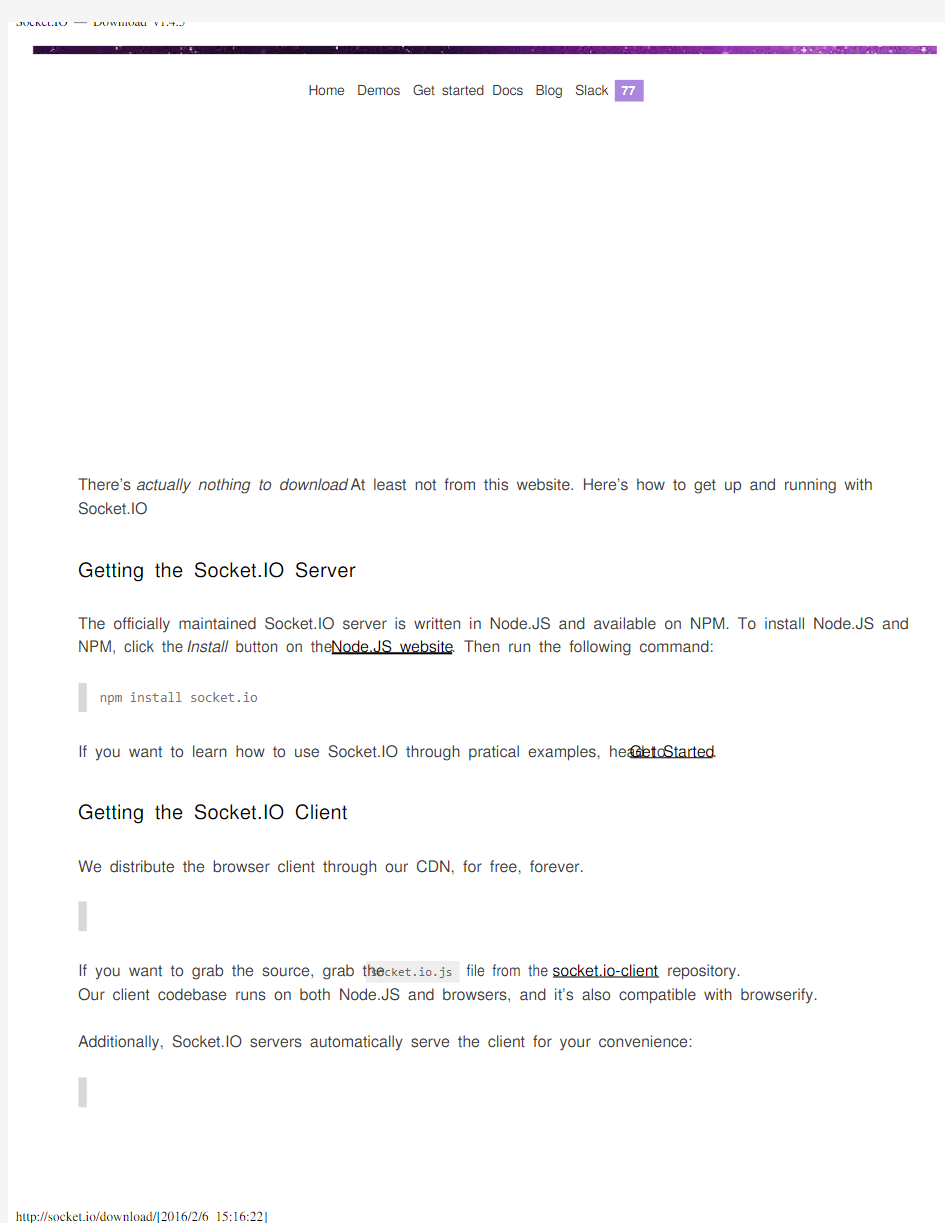Socket.IO


Overview Server API Client API
Rooms and Namespaces
Migrating from 0.9Using multiple nodes Logging and Debugging
FAQ
How to use
Installing
Using with Node http server
$ npm install socket.io
Home Demos Get started Docs Blog Slack 78
Server (app.js)
var app = require('http').createServer(handler)var io = require('socket.io')(app);var fs = require('fs');
Client (index.html)
Server (app.js)
var app = require('express')();
var server = require('http').Server(app);var io = require('socket.io')(server);server.listen(80);
app.get('/', function (req, res) {
res.sendfile(__dirname + '/index.html');});
io.on('connection', function (socket) { socket.emit('news', { hello: 'world' });
socket.on('my other event', function (data) { console.log(data); });});
Client (index.html)
Server (app.js)Client (index.html)
Sending and receiving events
Socket.IO allows you to emit and receive custom events. Besides connect
,
message
and
disconnect
, you can
emit custom events:Server
Restricting yourself to a namespace
If you have control over all the messages and events emitted for a particular application, using the default /namespace works. If you want to leverage 3rd-party code, or produce code to share with others, socket.io provides a way of namespacing a socket.This has the benefit of multiplexing
a single connection. Instead of socket.io using two
WebSocket
connections,
it’ll use one.
// note, io(
io.on('connection', function (socket) {
io.emit('this', { will: 'be received by everyone'});
socket.on('private message', function (from, msg) {
console.log('I received a private message by ', from, ' saying ', msg); });
socket.on('disconnect', function () { io.emit('user disconnected'); });});
var app = require('express').createServer();var io = require('socket.io')(app);app.listen(80);
app.get('/', function (req, res) {
res.sendfile(__dirname + '/index.html');});
io.on('connection', function (socket) {
socket.emit('news', { hello: 'world' });
socket.on('my other event', function (data) { console.log(data); });});
Sending volatile messages
Sometimes certain messages can be dropped. Let’s say you have an app that shows realtime tweets for the keyword bieber .
If a certain client is not ready to receive messages (because of network slowness or other issues, or because they’re connected through long polling and is in the middle of a request-response cycle), if they doesn’t receive ALL the tweets related to bieber your application won’t suffer.
In that case, you might want to send those messages as volatile messages.Server
var io = require('socket.io')(80);
io.on('connection', function (socket) { var tweets = setInterval(function () { getBieberTweet(function (tweet) {
socket.volatile.emit('bieber tweet', tweet); }); }, 100);
socket.on('disconnect', function () { clearInterval(tweets); });});
Server (app.js)
var io = require('socket.io')(80);var chat = io
.of('/chat')
.on('connection', function (socket) { socket.emit('a message', { that: 'only' , '/chat': 'will get' });
chat.emit('a message', { everyone: 'in' , '/chat': 'will get' }); });
var news = io .of('/news')
.on('connection', function (socket) { socket.emit('item', { news: 'item' }); });
Client (index.html)
Sending and getting data (acknowledgements)
Sometimes, you might want to get a callback when the client confirmed the message reception.To do this, simply pass a function as the last parameter of
.send
or
.emit
. What’s more, when you use
.emit
,
the acknowledgement is done by you, which means you can also pass data along:
Broadcasting messages
To broadcast, simply add a broadcast flag to emit and send method calls. Broadcasting means sending a message to everyone else except for the socket that starts it.Server
Using it just as a cross-browser WebSocket
If you just want the WebSocket semantics, you can do that too. Simply leverage send
and listen on the
message
event:
var io = require('socket.io')(80);
io.on('connection', function (socket) { socket.broadcast.emit('user connected');});
Server (app.js)
var io = require('socket.io')(80);
io.on('connection', function (socket) {
socket.on('ferret', function (name, fn) { fn('woot'); });});
Client (index.html)
Server (app.js)
var io = require('socket.io')(80);
Client (index.html)
